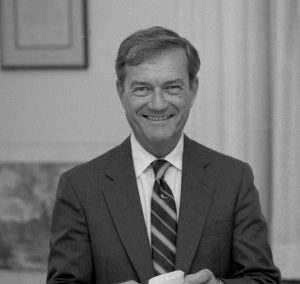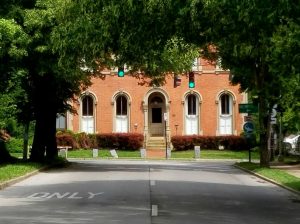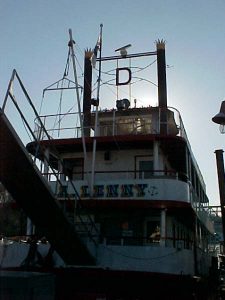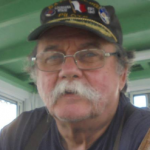The riverboat captain is a storyteller, and Captain Don Sanders will be sharing the stories of his long association with the river — from discovery to a way of love and life. This a part of a long and continuing story.
By Don Sanders
Special to NKyTribune
Although it’s been nearly sixty-seven years since I answered the alluring siren call beckoning me to the river, it’s not like I’ve never done anything else. Besides my college years, there was military service and an assorting of gigs I’ve done on my own. But whatever I did away from the water, the river in one way or another influenced my behavior in seemingly unrelated processes.
Take, for example, the restoration and renovation of historic homes in my hometown of Covington, Kentucky while I took a break from the DELTA QUEEN in the mid-1970s. At the beginning of the ‘70s, the prestigious National Trust for Historic Preservation, a privately-funded nonprofit organization dedicated to saving America’s historic places, chartered the QUEEN for private cruises for members of the Trust.

The prestigious National Trust for Historic Preservation, a privately-funded nonprofit organization dedicated to saving America’s historic places, chartered the QUEEN for private cruises for members of the Trust.
During every opportunity possible, I watched from the sidelines while speakers, both staff and guest, presented programs about the many involvements the National Trust was actively engaged in or endorsing. Our own Captain Clarke C. “Doc” Hawley talked about the history of steamboats on the Mississippi River System and so impressed the group, that he was offered a job in their Washington office, which he, of course, declined to remain “steamboatin’.”
The Trust’s president, James Biddle of the Philadelphia Biddles, better known within the gathering as “Jimmy,” proved to inspire my curiosity toward the historic preservation realm as did the first “keeper” of the National Register of Historic Places, Dr. William J.”Bill” Murtaugh. Bill also served as a Vice President of the National Trust and remained a friend and advisor for many years.
At the end of 1970, when the certainty of the fate of the DELTA QUEEN was in doubt following the exciting and eventful “Save the DELTA QUEEN” campaign of that year, and I was facing unemployment, was when I ventured into ownership of a historical and architecturally-significant home. I was young and what did I know? But when the opportunity presented itself, the lovely Harriett Albro Home in a rundown neighbor in downtown Covington was bought for an unbelievably cheap, but an affordable price of only $9,000. Suddenly, I was in the old-house ownership game.

The first “keeper” of the National Register of Historic Places, Dr. William J.”Bill” Murtaugh. Bill also served as a Vice President of the National Trust and remained a friend and advisor for many years.
Soon, I found what the financial community felt about my neighborhood when I asked a savings and loan institution for a $3,000 mortgage to buy the house next door before it fell into the hands of local “slumlords” eager to gobble up the property and cut it into multiple units and rent them as sub-standard housing. The same loan officer who lent me the balance of my home loan after I paid a third of the purchase price in cash, told me quite frankly:
“You have a nice home and your brother Bob has a nice home, but the rest of the neighborhood is a dump.”
In spite of his severe admonition, the moneylender approved my loan. Still reeling from the shock of hearing the solemn appraisal of my area, I ignored accepting the S&L’s credit.
After a multitude of pessimistic experiences throughout my life, I learned that “in every negative, there is a positive.” Instead of feeling rejection by my loan officer’s bizarre comments, I took his words as sound advice and began creating a new image for the neighborhood. Instead of decaying, roach and rat-infested hovels, scores of potential urban pioneers, swarming up and down the street, were visualizing how the area could be, and not how it was.

Albro House_Dietz Klefken – “You have a nice home and your brother Bob has a nice home, but the rest of the neighborhood is a dump.”
Some 13 properties, acquired as a result of the tours by interlopers brave enough to buy a ramshackle house, did so. In time, the seeds for a “new” neighborhood blossomed into what became the Old Seminary Square National Historic District. The modest double gable end house, I nearly snatched for three-grand, recently sold for over three hundred thousand dollars.
Realizing the potential of revitalizing the core of Covington into what I touted as the “closest neighborhood to downtown Cincinnati,” I inaugurated the first construction business, Landmark Restorations, operating within the guidelines of historic preservation in Northern Kentucky. Soon I was repairing homes in the Riverside Drive section of town for urban pioneers, Dick Smith, and John Kunkle. Dick and John deserve much of the credit for why the stately mansions were not destroyed long ago for what, as one prominent Covington business leader once stated at a public hearing, “hotels, motels, gas stations, and liquor stores.”
Smith and Kunkle came to the Greater Cincinnati Area from the east coast and immediately fell in love with the original section of Covington clustered between the Roebling Suspension Bridge and the Licking River.

The first old house Landmarks Restorations undertook in what became the Licking River Historic District was a project for Chuck Eilerman and his mother Carmen, at 628 Garrard Street.
Realizing developers were endangering the neighborhood, Dick and John joined ranks with others of like-mind in the Riverside section and bought specific strategic properties to make development in the area impractical. Thanks to them and others, including the popular attorney Pat Flannery, the Riverside National Historic District is a jewel any community would be proud to wear.
The first old house Landmarks Restorations undertook in what became the Licking River Historic District was a project for Chuck Eilerman and his mother Carmen, at 628 Garrard Street. Across the way, one block west, Jeannine VanDerVeer and her husband Steve McMurtry had their neighborhood restoration projects going. Jeannine, it turned out, was one of the most talented restoration contractors the city ever had. Primarily, it was Jeannine’s efforts and leadership in her end of town that made that neighborhood flourish.
Sadly, Jeannine died almost five years ago, and if there is another episode of bronze statuaries cast honoring Covington’s most celebrated, as there was some thirty years ago, a bronze statue of Ms. VanDerVeer would be an appropriate honor for the tireless neighborhood pioneer. The figure depicting Jeannine might be wearing jeans and an oversized paint shirt with her hair pulled atop her head and a smidgen of wet paint smeared on her nose; holding a paintbrush. Or else she might be elegantly clad in an all-white summer outfit of the late 19th or early 20th Centuries playing croquet in her yard with mallet-in-hand. Either rendition would suffice, as I remember seeing Jeannine attired both ways.

Jeannine, it turned out, was one of the most talented restoration contractors the city ever had. Primarily, it was Jeannine’s efforts and leadership in her end of town that made that neighborhood flourish.
Recognizing my interest in historic preservation and restoration I was appointed Vice-President of the Northern Kentucky Heritage League, and Vice-Chairman of Covington’s original Urban Design Board The president of the Heritage League, architect and historian George Roth became my mentor who taught me the fundamentals of the architecture of the region as seen through his trained eyes.
My standing in the League soon acted to my advantage when, in the Spring of 1974, Charles “Chuck” Eilerman called about a public hearing concerning the Kentucky State Highway’s plans to build a temporary bridge over the Licking River at the intersection of East 8th Street and Garrard Streets. The only sour apple in the scheme was that the highway would run straight the double parlors of the home built by banker Jonathan David Hearne.
At the hearing, Chuck and I found ourselves in unfriendly territory among the elite within the business community siding with the highwaymen eager to demolish the Hearne House for a temporary bridge while the nearby Fourth Street Bridge was having structural repairs made. Realizing that Chuck and I were the only two individuals in attendance opposing the project, impromptu rules immediately announced that “groups and organizations would be recognized first and individuals last.”

The only sour apple in the scheme was the highway would run straight through the double parlors of the home built by banker Jonathan David Hearne.
Quickly, we agreed on a plan – Chuck would represent the Christopher Gist Historical Society of Northern Kentucky, and I would speak as an officer of the Heritage League. Faces within the crowd fell when we announced our intentions.
Privately, Chuck revealed he had secured the Hearne House onto the National Register of Historic Places without the knowledge of the Highway Department or others supporting the demolition of the home. Inclusion on the Register would adversely affect Federal highway dollars assisting the project, without which, the Kentucky Highway Department would not undertake the expensive acquisition and demolition of the property and the construction of the temporary bridge without the U. S. Government’s financial assistance.
We listened as speakers droned on in support of the destruction of yet “another old house,” but the kicker came when a well-known accountant and business leader gave the speech, mentioned earlier, where he envisioned “gas stations, hotels, motels, liquor stores,” and worse instead of the beautiful architecturally-significant home and buildings in downtown Covington. Unsurprisingly, he had close ties to the alcoholic beverage distribution industry.
When I rose to speak before Chuck, I caused pandemonium in the meeting by announcing:
“I take extreme pleasure in welcoming the Jonathan David Hearne House to the National Register of Historic Places…”

Cappy Lawson Hamilton, the owner of the yet-to-be-finished P. A. DENNY Sternwheeler floating close-by, hired me for more money than I requested.
Long-story-short, the Hearne House was saved and still magnificently stands where it has since Mr. Hearne built it in the mid-nineteenth century.
Contrary to what most believe, being in front of the line with a new idea is not always the most beneficial position to occupy. Such was my experience in the infantile historic preservation movement as I was involved before the concept became acceptable. And the jobs I was getting were more like maintenance work than restoring old homes. When a late night phone call came for me to get dressed and change a lightbulb in the hallway of a house in a historic neighborhood, I refused, and my business relationship with that caller was over.
When after meticulously finishing the exterior trim on a celebrated row house on East Second Street, and the owners on either end of the seven-unit complex beat me out of their final payments, my thoughts returned to the river.
Miraculously, another call soon came across my phone line, this time the voice started:
“Hi, I’m Ross Tuckwiller in Charleston, West Virginia. We are completing the construction of a new sternwheel excursion boat, and Captain “Doc” Hawley gave us your name and recommended you for the Captain’s position. Think you might be interested enough to come up and look at the boat?”
Within a few days, I was standing under the coal tipple at Port Amherst on the Great Kanawha River, above Charleston, where Cappy Lawson Hamilton, owner of the yet-to-be-finished P. A. DENNY Sternwheeler floating close-by, hired me for more money than I requested.
Captain Don Sanders is a river man. He has been a riverboat captain with the Delta Queen Steamboat Company and with Rising Star Casino. He learned to fly an airplane before he learned to drive a “machine” and became a captain in the USAF. He is an adventurer, a historian, and a storyteller. Now, he is a columnist for the NKyTribune and will share his stories of growing up in Covington and his stories of the river. Hang on for the ride — the river never looked so good.
Click here to read all of Capt. Don Sanders’ stories of The River.


























Very interesting! I wish more people took to the preservation of historic homes in this way. Buildings and homes today just don’t have the same character as those from long ago. Would have loved to have been a fly on the wall during that meeting. I imagine you could hear the clatter as all those chins hit the floor!
I love this story! Thank you Capt. Don for sharing it and also for your work preserving the beautiful homes in Covington!
There were a lot more of us involved in the turn around of the Licking Riverside Neighborhood than was covered in your story Don. But I understand you have only so much time and space. Randy, Nancey and Mike, Truman, Lucille, Roger and Martha, John S, John C, just to name a few, put in a lot of blood sweat, and tears, and had a lot of fun in those days.